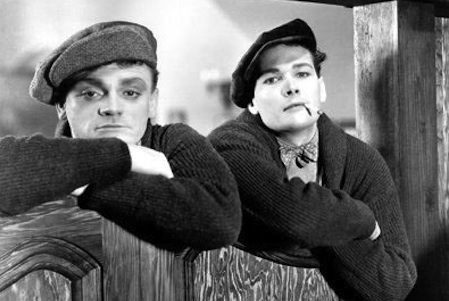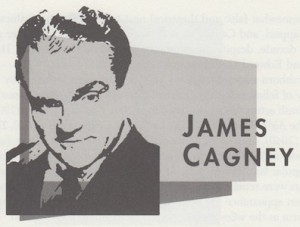Born: July 17, 1899, New York, NY
Died: March 30, 1986, Stanfordville, NY
He came on in the movies as though he were playing to the gallery in an opera house.
—Orson Welles
The product of New York City’s tough Lower East Side, James Cagney escaped to settlement-house vaudeville revues as a song-and-dance man in the 1920s. By 1930, he was a veteran of Broadway and ripe for a career in motion pictures.
Cagney’s first film was a repeat performance of his 1929 Broadway success Penny Arcade, called Sinner’s Holiday (1930), with actress Joan Blondell. His roots were evident when he was cast as a rough-hewn scrapper in The Public Enemy (1931), his most memorable role in the minds of Depression audiences. The angry, seething criminals he played in thirty-eight films, including The Roaring Twenties (1939), Angels with Dirty Faces (1938) and White Heat (1949), lifted a troubled Warners studio in the early sound era.
In fact, Cagney came to exemplify the first generation of sound stars. His choppy delivery and knowing sneer made audiences feel as if he were letting them in on a joke. Moviegoers easily impersonated his jerky shoulders, tiptoe stance and teeth-gritting lines like “You dirty rat.” His apparent comfort in criminal situations added a carefree swagger to his characterizations that translated to a deeper strength than his slight five-feet-six stature first suggested. His on-screen demeanor was so natural, in fact, that other actors seemed somewhat false and theatrical next to him. This naturalness heightened his appeal, and Cagney came to own the American gangster genre for an entire decade, despite the constant attempts by George Raft, Humphrey Bogart and Edward G. Robinson to unseat him.
The stubborn edge of Cagney’s persona was often softened by the Irish sensibility of fellow actor Pat O’Brien. Through films spanning four decades, the two brash actors fought side by side in Here Comes the Navy (1934), Devil Dogs of the Air (1935), The Irish in Us (1935), Ceiling Zero (1935), The Fighting 69th (1940) and Torrid Zone (1940). The cool logic of the fast-talking O’Brien was an excellent counter to the hotheaded impulsiveness of Cagney in the popular wartime dramas. After a twenty-year hiatus from acting, the two costars were reunited for the last time in Ragtime (1981). It would be the final screen appearance for both, and Cagney was hailed for getting back to rugged form as the wily curmudgeon Sheriff Rheinlander Waldo.
But Cagney won greatest critical praise for musicals like The Seven Little Foys (1955). He put his jittery gait to work as showman George M. Cohan in Yankee Doodle Dandy (1942) and won the Best Actor Oscar. Displaying a bravura unusual among sound film stars, he was a song-and-dance man of the highest order and embodied the American ideal of the tireless entertainer. Comic turns in A Midsummer Night’s Dream (1935) and Never Steal Anything Small (1959) further established his versatility.
Like Humphrey Bogart and Bette Davis, Cagney had signed an exclusive long-term contract with Warners that left him unhappy after his value skyrocketed. And like his predecessors, he battled to have his deal renegotiated; a sweeter deal in the 1950s afforded him an unprecedented share of decision making and profits. Later, Cagney would independently produce and distribute his own vehicles, including a tribute to Lon Chaney entitled Man of a Thousand Faces (1957).
Following comedic performances in Mister Roberts (1955) and Billy Wilder’s One Two Three (1961), Cagney retired for twenty years until director Miloš Forman enticed him with Ragtime (1981), after he had already been honored with a 1974 American Film Institute Life Achievement Award.
The first international star of the talkies, James Cagney smirked his way into the hearts of Depression audiences to become one of the most respected and beloved actors in cinema history. Moviegoers found his explosive temper, quick fists and grapefruit-squeezing boldness refreshing while they sat waiting for prosperity; Cagney seemed to offer cathartic escape through machine-gun justice that took him to the “Top of the world!”
To read all the republished articles from ‘The Film 100,’ as well as the complete list of 100 most influential people in the history of the movies, go to Reintroducing the Film 100 here on Keyframe.





